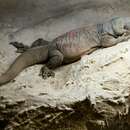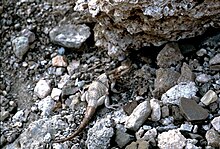fi
nimet breadcrumb-navigoinnissa


Čukvala (Sauromalus) je rod plazů z čeledi leguánů, žijících v pouštních oblastech na jihozápadě USA a v Mexiku.
Čukvaly dosahují obvykle délky okolo 30 cm, ale druh Sauromalus varius z ostrůvku San Esteban v Kalifornském zálivu dorůstá přes 60 cm a váží půldruhého kilogramu (tomuto jevu, kdy v prostředí zbaveném predátorů je živočich větší než jeho pevninští příbuzní, se říká ostrovní gigantismus).[1] Jsou převážně šedě zbarvené (samci mají na hřbetě červené skvrny), charakteristickým znakem je krátký tlustý ocas. Živí se rostlinnou potravou, převážně suchomilným keřem Larrea tridentata. Patří mezi teritoriální živočichy, samci si území značkují výměšky zvláštních holokrinních žláz na vnitřní straně stehen.[2] Tito pouštní ještěři musí dobře hospodařit s vodou, proto odpadní látky nevylučují močí, ale zbavují se jich kýcháním.[3]
Čukvala je aktivní při teplotách okolo 40 °C: v chladném počasí spí a většinu zbývajícího času se vyhřívá na rozpálených skalách. Trup je po stranách zploštělý a kůže visí ve volných záhybech; to umožňuje čukvalám ukrývat se před nepřáteli ve skalních štěrbinách. Ještěr pak nadme plíce a zaklíní se mezi kameny. Domorodci, pro které je maso čukvaly vyhledávanou pochoutkou, propichují plíce špičatým klackem, aby mohli tvora vytáhnout.[4]
Čukvala (Sauromalus) je rod plazů z čeledi leguánů, žijících v pouštních oblastech na jihozápadě USA a v Mexiku.
Die Chuckwallas (Sauromalus) sind eine Echsengattung aus der Familie der Leguane (Iguanidae). Ihr Verbreitungsgebiet umfasst die südwestlichen USA und Nordmexiko.
Chuckwallas erreichen eine Gesamtlänge von 32 bis 45 cm, wovon 18–20 cm auf den Körper entfallen, der Rest ist Schwanzlänge. Ihr Lebensraum sind trockene Regionen, wo sie sich oft auf sonnengewärmten Felsen aufhalten. Sie meiden allerdings offene Sandflächen. Bei Gefahr verkriechen sich die scheuen Tiere sofort unter einem Felsen, wo sie ihren Körper bis zu 60 % aufblähen können; dann ist es nicht möglich, sie aus ihrem Versteck herauszuholen.
Chuckwallas sind vorwiegend Pflanzenfresser; manchmal nehmen sie auch Insekten zu sich. Während der kühlen Monate halten sie Winterruhe. Im Sommer legt das Weibchen rund sechs Eier, aus denen im September der Nachwuchs schlüpft.
Die Gattung der Chuckwallas umfasst 5 rezente Arten, da Sauromalus australis und Sauromalus obesus keine eigenständigen Arten sind, sondern als Synonyme von Sauromalus ater gezählt werden.[1]
Die Chuckwallas (Sauromalus) sind eine Echsengattung aus der Familie der Leguane (Iguanidae). Ihr Verbreitungsgebiet umfasst die südwestlichen USA und Nordmexiko.
Chuckwallas are lizards found primarily in arid regions of the southwestern United States and northern Mexico. Some are found on coastal islands. The five species of chuckwallas are all placed within the genus Sauromalus; they are part of the iguanid family, Iguanidae.
The generic name, Sauromalus, is said to be a combination of two ancient Greek words: sauros meaning "lizard" and homalos (ὁμαλός) meaning "flat".[2][3] The common name "chuckwalla" derives from the Shoshone word tcaxxwal or Cahuilla čaxwal, transcribed by Spaniards as chacahuala.[4]
Chuckwallas are stocky, wide-bodied lizards with flattened midsections and prominent bellies. Their tails are thick, tapering to a blunt tip.[5] Loose folds of skin characterize the neck and sides of their bodies, which are covered in small, coarsely granular scales. The common chuckwalla (Sauromalus ater) measures 15 3/4 inches long, whereas insular species such as the San Esteban chuckwalla of San Esteban Island (Sauromalus varius) can measure as long as 30 in.
They are sexually dimorphic, with males having reddish-pink to orange, yellow, or light gray bodies and black heads, shoulders, and limbs; females and juveniles have bodies with scattered spots or contrasting bands of light and dark in shades of gray or yellow.[5] Males are generally larger than females and possess well-developed femoral pores located on the inner sides of their thighs; these pores produce secretions believed to play a role in marking territory.[5]
The genus Sauromalus has a wide distribution in biomes of the Sonoran and Mojave Deserts.[5] The common chuckwalla (S. ater) is the species with the greatest range, found from southern California east to southern Nevada and Utah and western Arizona, and south to Baja California and northwestern Mexico.[5] The peninsular chuckwalla (S. australis) is found on the eastern portion of the southern half of the Baja California Peninsula.[6]
The other species are island-dwelling, so have much more restricted distributions. The Angel Island chuckwalla (S. hispidus) is found on Isla Ángel de la Guarda and surrounding islands off the coast of the Baja California Peninsula.[7] Two rare and endangered species are the Montserrat chuckwalla (S. slevini) found on Islas Carmen, Coronados, and Montserrat in the southern Gulf of California and the San Esteban chuckwalla or painted chuckwalla (S. varius) found on San Esteban Island, Lobos, and Pelicanos.

Chuckwallas prefer lava flows and rocky areas[5] typically vegetated by creosote bush and other such drought-tolerant scrub. The lizards may be found at elevations up to 4,500 ft (1,370 m).[5]
Primarily herbivorous, chuckwallas feed on leaves, fruit, and flowers of annuals and perennial plants; insects represent a supplementary prey.[5] The lizards are said to prefer yellow flowers, such as those of the brittlebush (Encelia farinosa).[5]
Harmless to humans, these lizards are known to run from potential threats.[5] When disturbed, a chuckwalla wedges itself into a tight rock crevice and inflates its lungs to entrench itself.[5][8]
Males are seasonally and conditionally territorial; an abundance of resources tends to create a hierarchy based on size, with one large male dominating the area's smaller males.[5] Chuckwallas use a combination of color and physical displays, namely "push-ups", head-hobbing, and gaping of the mouth, to communicate and defend their territory.[5]
Chuckwallas are diurnal animals and as they are ectothermic, spend much of their mornings and winter days basking.[5] These lizards are well adapted to desert conditions; they are active at temperatures up to 39 °C (102 °F). Chuckwallas hibernate during cooler months and emerge in February.[5] Juveniles emerge first, then adults, as temperatures reach around 32 °C (90 °F).[5]
Mating occurs from April to July, with five to 16 eggs laid between June and August. The eggs hatch in late September.[5] Chuckwallas may live for 25 years or more.
The Seri people considered the Angel Island species of chuckwalla an important food item.[9] They are believed to have translocated the lizards to most of the islands in Bahia de los Angeles for use as a food source in times of need.[7]
Chuckwallas are lizards found primarily in arid regions of the southwestern United States and northern Mexico. Some are found on coastal islands. The five species of chuckwallas are all placed within the genus Sauromalus; they are part of the iguanid family, Iguanidae.
Los chacahualas (género Sauromalus) son lagartos de la familia iguanidae. Habitan las regiones desérticas del suroeste estadounidense y los estados mexicanos norteños. Hay cinco especies. Su nombre viene de la palabra "tcaxxwal" (empleada por los shoshones) o "caxwal", de origen cahuilla.
Está conformado por las siguientes especies:[1]
Los chacahualas (género Sauromalus) son lagartos de la familia iguanidae. Habitan las regiones desérticas del suroeste estadounidense y los estados mexicanos norteños. Hay cinco especies. Su nombre viene de la palabra "tcaxxwal" (empleada por los shoshones) o "caxwal", de origen cahuilla.
Sauromalus Iguanidae familiako narrasti genero bat da. Mexiko eta Ameriketako Estatu Batuetan bizi dira.
Sauromalus Iguanidae familiako narrasti genero bat da. Mexiko eta Ameriketako Estatu Batuetan bizi dira.
Sauromalus est un genre de sauriens de la famille des Iguanidae[1].
Les espèces de ce genre se rencontrent dans le sud-ouest des États-Unis et dans le nord-ouest du Mexique[1].
Selon Reptarium Reptile Database (3 décembre 2012)[2] :
Sauromalus australis et Sauromalus obesus sont synonymes de Sauromalus ater.
Le nom de genre, Sauromalus, est une combinaison de deux mots en grec ancien : σαῦρος (sauros) signifiant "lézard", et ομαλυς (omalus) signifiant "plat"[3].
Ioguán ó Mheiriceá Thuaidh a fhaightear i bhfásaigh charraigeacha is ea an Cacabhala. An cholainn dorcha le heireaball ramhar maol buí, gan chíor ar feadh a dhroma. Itheann sé plandaí. Glacann sé suaimhneas i scáintí sna carraigeacha. Má chuirtear isteach air, is féidir go ndingfidh sé é féin sa scáineadh trína scamhóga a bhorradh.
Sauromalus – rodzaj jaszczurki z rodziny legwanowatych (Iguanidae).
Rodzaj obejmuje gatunki występujące na Antylach[3].
Sauromalus: gr. σαυρος sauros „jaszczurka”[4]; ομαλος homalos „równy, gładki”[5].
Do rodzaju należą następujące gatunki[3]:
Sauromalus – rodzaj jaszczurki z rodziny legwanowatych (Iguanidae).
Sauromalus é um género de réptil da ordem Squamata, família Iguanidae.[1] Inclui lagartos grandes, nativos da América do Norte, os quais são onívoros, mas predominantemente herbívoros, e chamados localmente de "Chuckwalla".
O porte das espécies varia, mas costumam ser pouco menores que as iguanas gigantes propriamente ditas. São espécies citadas em livros de terrariofilia.
Sauromalus é um género de réptil da ordem Squamata, família Iguanidae. Inclui lagartos grandes, nativos da América do Norte, os quais são onívoros, mas predominantemente herbívoros, e chamados localmente de "Chuckwalla".
O porte das espécies varia, mas costumam ser pouco menores que as iguanas gigantes propriamente ditas. São espécies citadas em livros de terrariofilia.
Sauromalus là chi gồm các loài thằn lằn lớn trong họ Cự đà, được tìm thấy chủ yếu trong các vùng khô hạn của tây nam Hoa Kỳ và bắc México. Một vài loài được tìm thấy trên các đảo ven bờ. Chi này có 5 loài.
Phương tiện liên quan tới Sauromalus tại Wikimedia Commons
Sauromalus là chi gồm các loài thằn lằn lớn trong họ Cự đà, được tìm thấy chủ yếu trong các vùng khô hạn của tây nam Hoa Kỳ và bắc México. Một vài loài được tìm thấy trên các đảo ven bờ. Chi này có 5 loài.